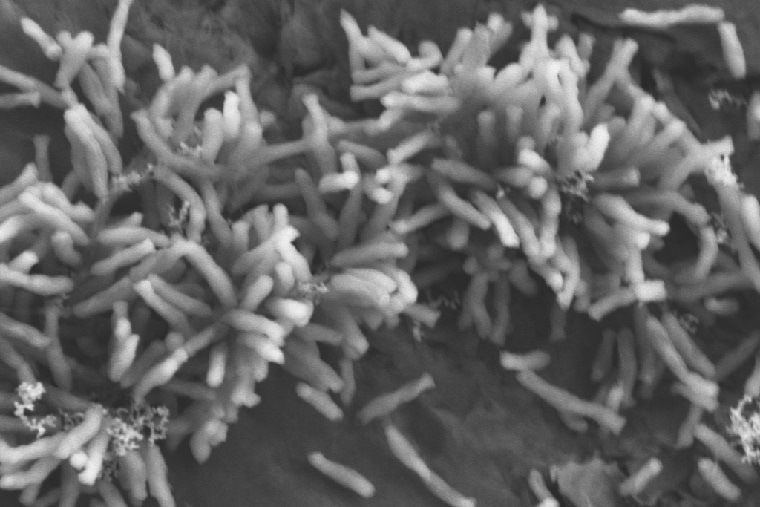Mar 25 2019
A new study at Washington University in St. Louis describes the cellular processes that enable a sun-loving microbe to “eat” electricity, by which electrons are transferred to fix carbon dioxide to promote its growth.
 A Washington University team showed how a phototrophic microbe called Rhodopseudomonas palustris takes up electrons from conductive substances like metal oxides or rust to reduce carbon dioxide. (Image credit: Bose laboratory, Washington University in St. Louis)
A Washington University team showed how a phototrophic microbe called Rhodopseudomonas palustris takes up electrons from conductive substances like metal oxides or rust to reduce carbon dioxide. (Image credit: Bose laboratory, Washington University in St. Louis)
A Washington University team headed by Arpita Bose, assistant professor of biology in Arts & Sciences, and Michael Guzman, a PhD candidate in her laboratory, demonstrated how a naturally occurring strain of Rhodopseudomonas palustris acquires electrons from conductive substances such as metal oxides or rust. The research featured in a paper published on March 22nd, 2019 in the journal Nature Communications.
The research is based on Bose’s previous finding that R. palustris TIE-1 can use up electrons from rust proxies such as poised electrodes through a process known as extracellular electron uptake. R. palustris is phototrophic, which denotes that it uses light energy to perform certain metabolic processes. The new study describes the cellular sinks where this microbe leaves the electrons it consumes from electricity.
It clearly shows for the first time how this activity—the ability for the organism to eat electricity—is connected to carbon dioxide fixation.
Arpita Bose, Assistant Professor of Biology, Department of Arts & Sciences, Washington University in St. Louis.
Bose is also a Packard Fellow who investigates microbial metabolisms and their effect on biogeochemical cycling.
This mechanistic insight can help guide attempts to exploit the microbe’s natural potential for sustainable energy storage or other bioenergy applications. This capability has gained the attention of the Department of Energy and Department of Defense.
R. palustris strains can be found in wild and exotic places like a rusty bridge in Woods Hole, Massachusetts where TIE-1 was isolated from,” stated Bose. “Really, you can find these organisms everywhere. This suggests that extracellular electron uptake might be very common.
The main challenge is that it’s an anaerobe, so you need to grow it in an environment that doesn’t have oxygen in order for it to harvest light energy. But the flip side to that is that those challenges are met with a lot of versatility in this organism that a lot of other organisms don’t have.
Michael Guzman, PhD Candidate, Washington University in St. Louis.
As part of the new study, the scientists demonstrated that the electrons from electricity penetrate through the proteins in the membrane that are vital for photosynthesis. Astonishingly, when they removed the microbe’s potential to fix carbon dioxide, they noted a 90% decrease in its potential to use up electricity.
“It really wants to fix carbon dioxide using this system,” stated Bose. “If you take it away—this innate ability—it just doesn’t want to take up electrons at all.”
Bose said that the reaction is analogous to a rechargeable battery in a few ways.
“The microbe uses electricity to charge its redox pool, storing up the electrons and making it highly reduced,” stated Bose. “To discharge it, the cell reduces carbon dioxide. The energy for all this comes from sunlight. The whole process keeps repeating itself, allowing the cell to make biomolecules with nothing more than electricity, carbon dioxide and sunlight.”
An all-Washington University group overcame several technical obstacles to accomplish this research. Mark Meacham from the McKelvey School of Engineering helped to create and produce the microfluidic devices that enabled the scientists to focus on the activities that were occurring in cells as the bacteria consumed from electricity sources. The group also depended on support from partners including David Fike in the earth and planetary sciences department, who helped Bose and Guzman to use secondary ion mass spectrometry to identify how the microbe uses carbon dioxide.
The new study provides solutions to fundamental science queries and offers a lot of possibility for future bioenergy applications.
“For a long time, people have known that microbes can interact with analogues of electrodes in the environment—that is, minerals that are also charged,” noted Guzman. “But no one really appreciated how this process could also be done by photoautotrophs, such as these types of organisms that fix their own carbon and use light to make energy. This research fills a poorly understood gap in the field.”
Bose’s lab is taking efforts to produce biofuels and bioplastics using these microbes.
We hope that this ability to combine electricity and light to reduce carbon dioxide might be used to help find sustainable solutions to the energy crisis.
Arpita Bose, Assistant Professor of Biology, Department of Arts & Sciences, Washington University in St. Louis.
The Initiative for Maximizing Student Development (IMSD) training grant from the National Institutes of Health (R25-GM103757) supported Guzman. This research was supported by Bose grants: The David and Lucile Packard Foundation Fellowship (201563111), the U.S. Department of Energy (DESC0014613), and the U.S. Department of Defense, Army Research Office (W911NF-18-1-0037). Bose grants that also supported this research include a Collaboration Initiation Grant, an Office of the Vice Chancellor of Research Grant, and an International Center for Energy, Environment and Sustainability Grant from Washington University in St. Louis.
Bacteria that Eat Electricity | Washington University
(Video credit: Washington University in St. Louis)